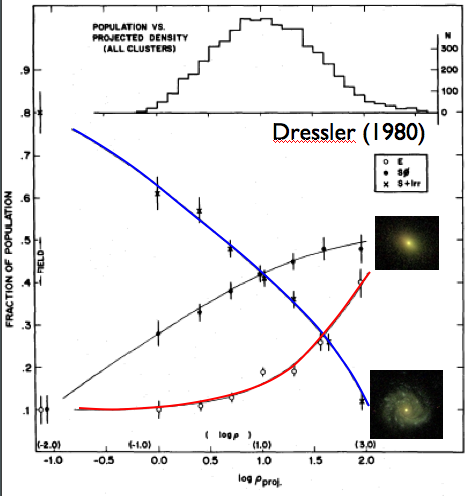Public pages > Galaxy ecology
Connecting galaxies with their environment
Galaxy clusters are the 'big cities' of the Universe: places where hundreds or even thousands of galaxies are gradually pulled together by the inexorable force of gravity. Orbiting around each other like a swarm of bees, the galaxies in these regions have been known for a long time to look very similar. The figure to the right is known as the 'morphology-density' relationship.
It looks at connections between a galaxy's shape and how many
neighbours it has. We can see that as we move further into the
most crowded regions of a galaxy cluster, the galaxies that live there
are mostly rounded elliptical balls of stars. By contrast,
galaxies living quiet lives in isolated regions of space are more
likely to be disky spiral galaxies (like our own galaxy, the Milky Way).
The figure to the right is known as the 'morphology-density' relationship.
It looks at connections between a galaxy's shape and how many
neighbours it has. We can see that as we move further into the
most crowded regions of a galaxy cluster, the galaxies that live there
are mostly rounded elliptical balls of stars. By contrast,
galaxies living quiet lives in isolated regions of space are more
likely to be disky spiral galaxies (like our own galaxy, the Milky Way).Shape is not the only property of a galaxy that varies with environment. Astronomers also find that a galaxy's colour (red or blue), amount of star formation (vigorous or defunct), and whether or not it has an active galactic nucleus (AGN) also depends on where it lives. The observational picture we see leads us to conclude that galaxies in the densest regions are mostly older, rounder, and as far as star-formation is concerned - dead.
How could this scenario have come to be? One option is that it's all down to "nature": those galaxies in densest regions formed first, and therefore have had more time to sit around becoming old and boring. In essence, they have had a head start. On the other hand, it's very likely that "nurture" has an important role to play: one or more aspects of environment may have been actively transforming galaxies.
The violent lives of galaxies
What external forces could work on galaxies? Well, when we talk about the "environment" of a galaxy, we mean:- how many neighbours (ie other galaxies) are nearby;
- how much hot gas it is plowing through; and
- how much dark matter surrounds it.

There is great potential for life in the big city to be very violent: galaxies in clusters can be collide with each other, be pulled apart by gravity, and have their fuel supply (the material from which they form new stars) stripped away. We use colourful terms like 'harrassment', 'merging', 'strangulation', 'stripping', 'starvation', and 'suffocation' to describe the physics at work. All these mechanisms could plausibly change the way a galaxy looks and work to shut off its star formation.
One final piece of the puzzle to consider is how big the galaxy is. Just as a heavyweight fighter can withstand a blow that would bring a normal person to his knees, a big galaxy is more resistant to being messed around by its local environment. We might expect that the smallest galaxies are the ones that are most likely to be affected by external forces.
STAGES: galaxy evolution in dense environments
To really understand the importance of environment on galaxy evolution, we would therefore like to be able to- study galaxies living in a large range of environments (from isolated galaxies to the densest cluster cores);
- probe all aspects of environment (dark matter, hot gas, and galaxy density);
- look at all galaxy properties (shape, colour, star formation); and
- examine galaxies from the massive giants all the way down to the low-mass dwarf galaxies.

That's where the STAGES survey of the Abell 901/902 supercluster comes in: we select a particularly interesting target (a complex multiple-cluster region still in the process of formation) and examine it in great detail using some of the most powerful telescopes on Earth and in space. By doing so we hope to disentangle each piece of the puzzle and determine just how much a galaxy's life is affected by the neighbourhood in which it lives.



